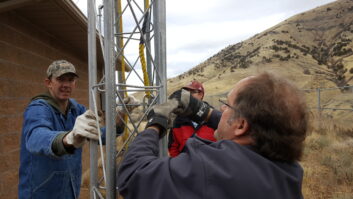
Road warriors look for devices and tools that will make our lives in the field more efficient. I recently ran across another that solves problems of power and portability, a device from Voltaic Systems in New York called the Voltaic Backpack.
It is a solar backpack that weighs 3.5 pounds, carries 1,850 cubic inches worth of cargo and charges small electronics like cell phones, BlackBerrys, cameras and recorders like the M-Audio MicroTrack II. All of this in dimensions of 20 inches high, 10 to 15 inches wide and 7 to 10 inches deep. I was able to get a hands-on demonstration thanks to the staff at Global Satellite USA in Fort Lauderdale, Fla.
The Voltaic Backpack has three solar panels, which are rated to produce a total of 4 W of power.
The Backpack uses a 3.6 V, 4,400 mAh lithium-ion battery to store solar power. The battery will take a charge from any ambient light of sufficient brightness, as well as a charge from a DC car charger or AC wall charger. An indicator illuminates when the solar panels are receiving enough light to charge the internal battery.
The Backpack comes with 11 standard electronic adapters for various devices, a car charger socket and a USB adapter.
Voltaic Systems says the system will produce enough power to charge a cell phone fully in 4 to 6 hours of direct sunlight.
The panels also provide some hard-shell protection for items inside like a laptop of up to 17 inches. Note though that the Voltaic Backpack is not designed to charge a laptop. Fear not: the company’s Generator solar laptop charger briefcase model will charge a laptop and any other small device, with up to 15 watts of power stored in the battery. The Generator has a 700-cubic inch capacity inside.
The MSRP for the Voltaic Backpack is $249 and for the Generator briefcase model $499. A smaller pack called the Converter, with the same functionality of the Backpack but in a smaller daypack size, retails for $199.
These products, excluding the actual solar cells, are made out of recycled plastic bottles.
Power points
Speaking of power …

Fig. 1: Voltaic Systems Backpack

Fig. 2: Voltaic Systems Generator is a briefcase-style solar power generator.
Power points in cars are useful to road warriors who use BlackBerrys, M-Audio MicroTrack I or II audio recorders and other DC-powered items that can charge from a vehicle’s 12 V electrical system.
Both the BlackBerry and MicroTrack use a mini USB connection for charging internal batteries and transferring audio.

Fig. 3: Voltaic Systems products come with a wealth of adapters; this is the full line. A device that converts 12 V to 5 V through a USB connection will top off either device while driving. But what about other 12 V devices that need to be connected (like a Jabra Bluetooth headset charger) at the same time? How does one change the 12 V from the vehicle into USB (5 V) voltage?
A trip through a Wal-Mart auto section found the adapter shown in Fig. 4. It sits in a cup holder and connects to a 12 V power point. It includes two USB power points and two standard 12 V power points in a small footprint, so a total of four devices can charge or be connected on that road trip. That will save time and trouble when the reporter gets to the assignment.
Let’s wind up this edition with a solution to an operational problem, to wit:
You must process audio before the news conference or event finishes. In the old days, odds were that you didn’t have a second recorder so you would have to wait until the entire recording was finished before starting to process audio. With modern digital recorder technology there’s a workaround if you have a laptop. And it won’t cost a lot of money. Maybe 10 bucks!
This will work with the Marantz PMD660/670 and 671 series of CompactFlash recorders or the MicroTrack I and II series recorders.
Here’s how you do it. You’ll need a laptop with a built-in card reader but if you don’t have the reader, just drop by a big box retailer like Office Depot and buy a USB card reader for the princely sum of around $9.99.
At your next gig wait until a short natural break (e.g., between speakers or when a PowerPoint presentation is starting), then swap out CompactFlash cards while leaving the recorder connected to a microphone or mult box.

Fig. 4: A 12 V Converter for USB Use Once the recorder is rerolling, take the card to the laptop or the card reader connected to the laptop. Insert card and you’re off multitasking.
This obvious yet underutilized trick saves me time if, for instance, some of the audio is required for reports that will be due quickly after the event. Also it saves time with the Marantz units in particular, since those recorders are USB 1.1 devices and are slower in data transfer than USB 2.0 machines. And, of course, this work as well.
When a problem can be solved, and for not much money, that’s the kind of thinking that will help news departments save resources and weather economic storms.
INFOVoltaic Systems
(877) 304-6861
www.voltaicsystems.com
Global Satellite
(800) 263-5450
www.globalsatellite.us
This tip is a preview of our next Road Warrior column, which will include hints on working with a laptop in the field and on how to use a PDA with Wi-Fi capabilities to send news reports and actualities to the studio for processing. Your suggestions could help other readers; please consider sharing them with us for our next column.
We’re also looking for radio reporters to share stories of their favorite news microphone; why they like it; any road warrior stories that developed because of their use of said mic and a picture of those reporters and the mic at work. As always, we welcome your suggestions for future columns.
Paul Kaminski is the news director for the Motor Sports Radio Network, a contributor for CBS News Radio and a contributor and columnist for Radio World. Send e-mail tomotorsportsradio@msrpk.com.







